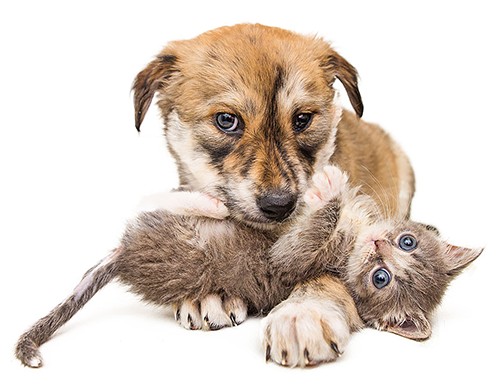Dogs may need some time decompressing depending on the situation they’ve come from. Your new foster dog may act differently than predicted, so let him/her settle down and acclimate to your home before seeking out contact and interactions. When the dog is ready, he/she will come to you. You can sit on the floor and encourage the dog with treats or by gently calling his/her name.
Remember to take things slow. No parties, special trips and limited visitors until your new foster dog is more comfortable. When it’s time to introduce your foster dog to your current pets, go slow and supervise at all times, preferably with assistance.
Establish a routine. Dogs have a better time acclimating when meals, walks and bedtime happen at a consistent time. It is normal for your foster dog to have less of an appetite, soft stools, or sleep a lot for the few days or so.
Some dogs may be used to a home environment while others may not. Their backgrounds will vary, with some having had amazing bonds with people, while others may have been abused or neglected. Please remember to give them patience, support and love as you help save their lives.
Cats will also need some time adjusting to a new home environment, especially older cats who may have spent their entire lives in one home before coming to the shelter. A normal reaction for cats may be to hide.
Allow your foster cat time to adjust to your home by giving them a safe space of their own, such as a roomy crate, spare bedroom, or extra bathroom. Block off small areas where the cat may hide and get stuck. Scared cats can hurt themselves by wedging into small areas or escape by dashing out an open front door if they are not confined.
Never try to pull your foster cat out of hiding. Sit on the floor with treats and softly call the cat’s name to try to encourage them. Sit on the floor and read a book or newspaper so the cat gets used to your voice. Once he/she is used to you, the cat will approach you when ready.
When your foster cat is eating, drinking, using the litter box and walking around the room in a relaxed manner, he/she may be ready to explore more of the house (after the initial quarantine period). However, if the cat runs when you enter the room, hides, only eats or uses the litter box at night, slinks around the room with body low to the ground, hisses, growls or cowers, these are signs of fear and means he/she is not ready to come out of confinement yet. Keep him/her confined and contact our foster team if there is no progress after one week.
Foster pets should remain separated from resident pets for at least 14 days to prevent possible spread of disease. Moms, babies & neonates should always be separated.





















